MERCEDES-BENZ METRIS 2020 MY20 Operator’s Manual
Manufacturer: MERCEDES-BENZ, Model Year: 2020, Model line: METRIS, Model: MERCEDES-BENZ METRIS 2020Pages: 320, PDF Size: 26.38 MB
Page 301 of 320
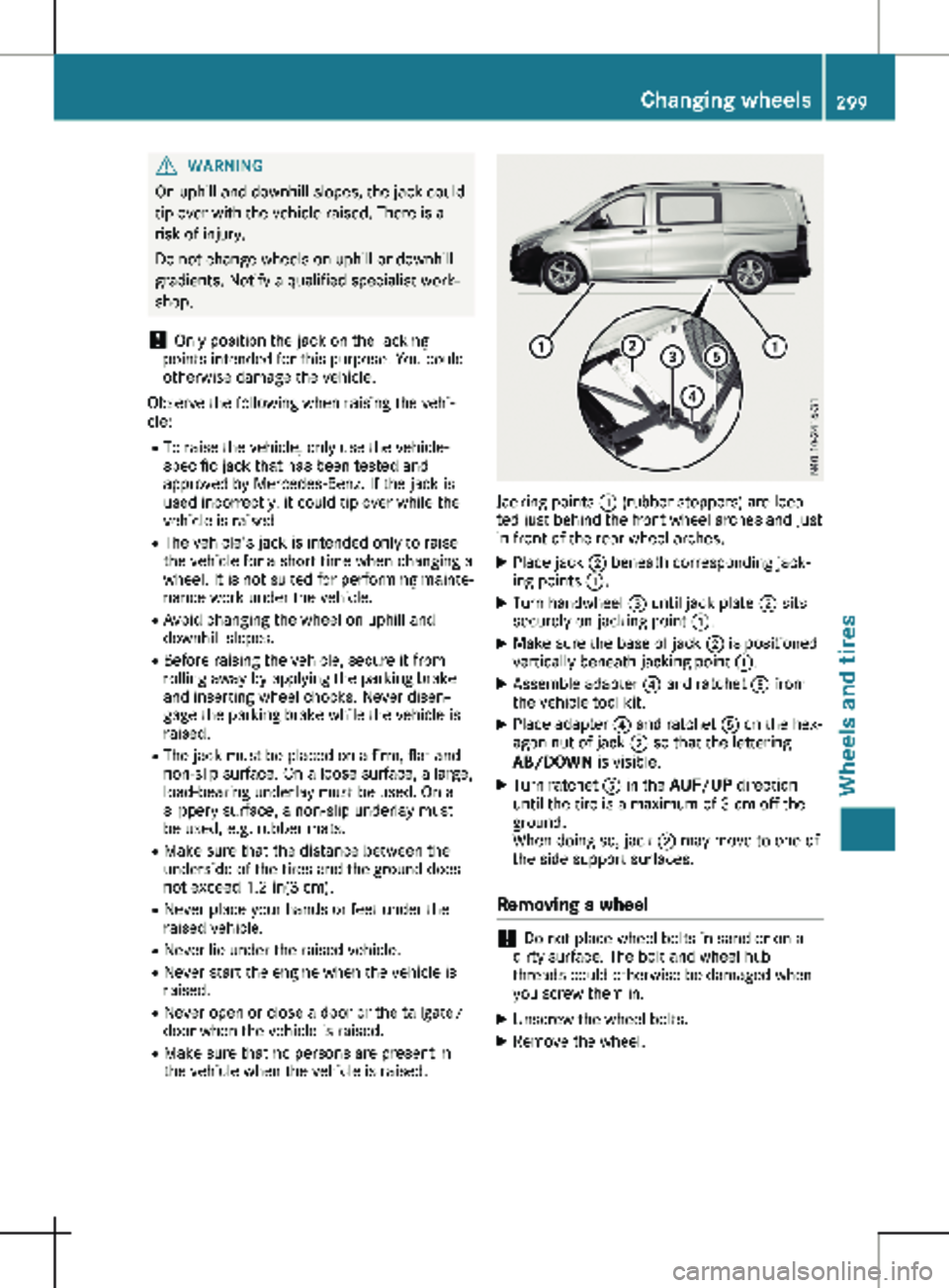
G
WARNING
On uphill and downhill slopes, the jack could
tip over with the vehicle raised. There is a
risk of injury.
Do not change wheels on uphill or downhill
gradients. Notify a qualified specialist work-
shop.
! Only position the jack on the jacking
points intended for this purpose. You could
otherwise damage the vehicle.
Observe the following when raising the vehi-
cle:
R To raise the vehicle, only use the vehicle-
specific jack that has been tested and
approved by Mercedes-Benz. If the jack is
used incorrectly, it could tip over while the
vehicle is raised.
R The vehicle's jack is intended only to raise
the vehicle for a short time when changing a
wheel. It is not suited for performing mainte-
nance work under the vehicle.
R Avoid changing the wheel on uphill and
downhill slopes.
R Before raising the vehicle, secure it from
rolling away by applying the parking brake
and inserting wheel chocks. Never disen-
gage the parking brake while the vehicle is
raised.
R The jack must be placed on a firm, flat and
non-slip surface. On a loose surface, a large,
load-bearing underlay must be used. On a
slippery surface, a non-slip underlay must
be used, e.g. rubber mats.
R Make sure that the distance between the
underside of the tires and the ground does
not exceed
1.2 in(3 cm).
R Never place your hands or feet under the
raised vehicle.
R Never lie under the raised vehicle.
R Never start the engine when the vehicle is
raised.
R Never open or close a door or the tailgate/
door when the vehicle is raised.
R Make sure that no persons are present in
the vehicle when the vehicle is raised. Jacking points : (rubber stoppers) are loca-
ted just behind the front wheel arches and just
in front of the rear wheel arches.
X Place jack ; beneath corresponding jack-
ing points :.
X Turn handwheel = until jack plate ; sits
securely on jacking point :.
X Make sure the base of jack ; is positioned
vertically beneath jacking point :.
X Assemble adapter ? and ratchet A from
the vehicle tool kit.
X Place adapter ? and ratchet A on the hex-
agon nut of jack ; so that the lettering
AB/DOWN is visible.
X Turn ratchet A in the AUF/UP direction
until the tire is a maximum of 3 cm off the
ground.
When doing so, jack ; may move to one of
the side support surfaces.
Removing a wheel !
Do not place wheel bolts in sand or on a
dirty surface. The bolt and wheel hub
threads could otherwise be damaged when
you screw them in.
X Unscrew the wheel bolts.
X Remove the wheel. Changing wheels
299
Wheels and tires Z
Page 302 of 320
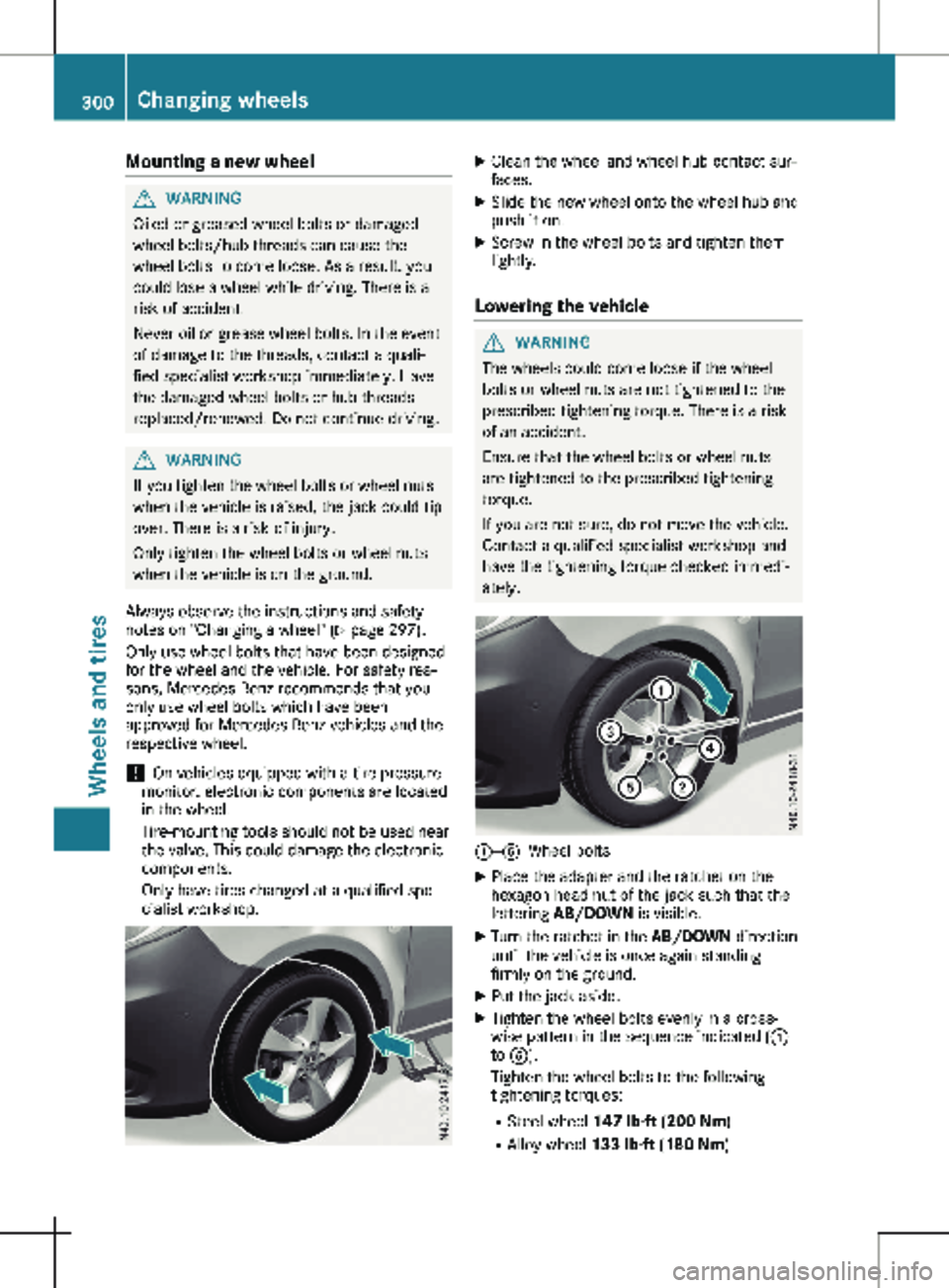
Mounting a new wheel
G
WARNING
Oiled or greased wheel bolts or damaged
wheel bolts/hub threads can cause the
wheel bolts to come loose. As a result, you
could lose a wheel while driving. There is a
risk of accident.
Never oil or grease wheel bolts. In the event
of damage to the threads, contact a quali-
fied specialist workshop immediately. Have
the damaged wheel bolts or hub threads
replaced/renewed. Do not continue driving. G
WARNING
If you tighten the wheel bolts or wheel nuts
when the vehicle is raised, the jack could tip
over. There is a risk of injury.
Only tighten the wheel bolts or wheel nuts
when the vehicle is on the ground.
Always observe the instructions and safety
notes on "Changing a wheel"
(Y page 297).
Only use wheel bolts that have been designed
for the wheel and the vehicle. For safety rea-
sons, Mercedes-Benz recommends that you
only use wheel bolts which have been
approved for Mercedes-Benz vehicles and the
respective wheel.
! On vehicles equipped with a tire pressure
monitor, electronic components are located
in the wheel.
Tire-mounting tools should not be used near
the valve. This could damage the electronic
components.
Only have tires changed at a qualified spe-
cialist workshop. X
Clean the wheel and wheel hub contact sur-
faces.
X Slide the new wheel onto the wheel hub and
push it on.
X Screw in the wheel bolts and tighten them
lightly.
Lowering the vehicle G
WARNING
The wheels could come loose if the wheel
bolts or wheel nuts are not tightened to the
prescribed tightening torque. There is a risk
of an accident.
Ensure that the wheel bolts or wheel nuts
are tightened to the prescribed tightening
torque.
If you are not sure, do not move the vehicle.
Contact a qualified specialist workshop and
have the tightening torque checked immedi-
ately. :—A
Wheel bolts
X Place the adapter and the ratchet on the
hexagon head nut of the jack such that the
lettering AB/DOWN is visible.
X Turn the ratchet in the AB/DOWN direction
until the vehicle is once again standing
firmly on the ground.
X Put the jack aside.
X Tighten the wheel bolts evenly in a cross-
wise pattern in the sequence indicated (:
to A).
Tighten the wheel bolts to the following
tightening torques:
R Steel wheel 147 lb-ft (200 Nm)
R Alloy wheel 133 lb-ft (180 Nm)300
Changing wheels
Wheels and tires
Page 303 of 320

X
Turn the jack back to its out-of-use position.
X Stow the jack and the rest of the tire-
change tool kit in the vehicle again.
X Wheel with hub cap: position the opening
for the tire valve in the hub cap over the tire
valve.
X Push the edge of the hub cap with both
hands against the wheel until it clicks into
place. Make sure the hub cap retaining
catches engage on the steel wheel.
X If included in the vehicle equipment, secure
the faulty wheel in the spare wheel bracket
(Y page
303). Otherwise, transport the
faulty wheel in the cargo compartment.
X Check the tire pressure of the newly moun-
ted wheel and adjust it if necessary.
Observe the recommended tire pressure
( Y page
282).
Vehicles with the tire pressure monitor sys-
tem: all mounted wheels must be equipped
with functioning sensors.
X Retighten the wheel bolts or wheel nuts to
the specified tightening torque after the
vehicle has been driven for
30 miles
(50 km).
When using a wheel/spare wheel with a new
or newly painted wheel rim, have the wheel
bolts/nuts retightened again after approx-
imately
600 to 3,000 miles (1,000 to
5,000 km). Observe the specified tightening
torque. Wheel and tire combinations
General notes
! Retreaded tires are neither tested nor rec-
ommended by Mercedes-Benz, since previ-
ous damage cannot always be detected on
retreaded tires. As a result, Mercedes-Benz
cannot guarantee vehicle safety if retreaded
tires are mounted. Do not mount used tires
if you have no information about their previ-
ous usage.
! For safety reasons, Mercedes-Benz recom-
mends that you only use tires, wheels and accessories which have been approved by
Mercedes-Benz specifically for your vehicle.
These tires have been specially adapted for
use with the driving safety systems, such as
ABS or ESP
®
.
Only use tires, wheels or accessories tested
and approved by Mercedes-Benz. Certain
characteristics, e.g. handling, vehicle noise
emissions or fuel consumption, may other-
wise be adversely affected. In addition,
when driving with a load, tire dimension var-
iations could cause the tires to come into
contact with the bodywork and axle compo-
nents. This could result in damage to the
tires or the vehicle.
Mercedes-Benz accepts no liability for dam-
age resulting from the use of tires, wheels
or accessories other than those tested and
approved.
Further information on wheels, tires and
approved combinations can be obtained
from a qualified specialist workshop.
! Large wheels: the lower the section width
for a certain wheel size, the lower the ride
comfort is on poor road surfaces. Roll com-
fort and suspension comfort are reduced
and the risk of damage to the wheels and
tires as a result of driving over obstacles
increases.
You will find a table with the recommended
tire pressures for various vehicle loads on the
inside of your vehicle's fuel filler flap or under
"Tire pressure tables"
(Y page 289). You can
find further information under "Tire pressure"
( Y page 282).
Check tire pressures regularly and only when
the tires are cold.
Notes on the vehicle equipment – always
equip the vehicle:
R with tires of the same size across an axle
(left/right)
R with the same type of tires on all wheels at
a given time (summer tires, winter tires)
i Not all wheel/tire combinations can be
installed at the factory in all countries. Wheel and tire combinations
301
Wheels and tires Z
Page 304 of 320
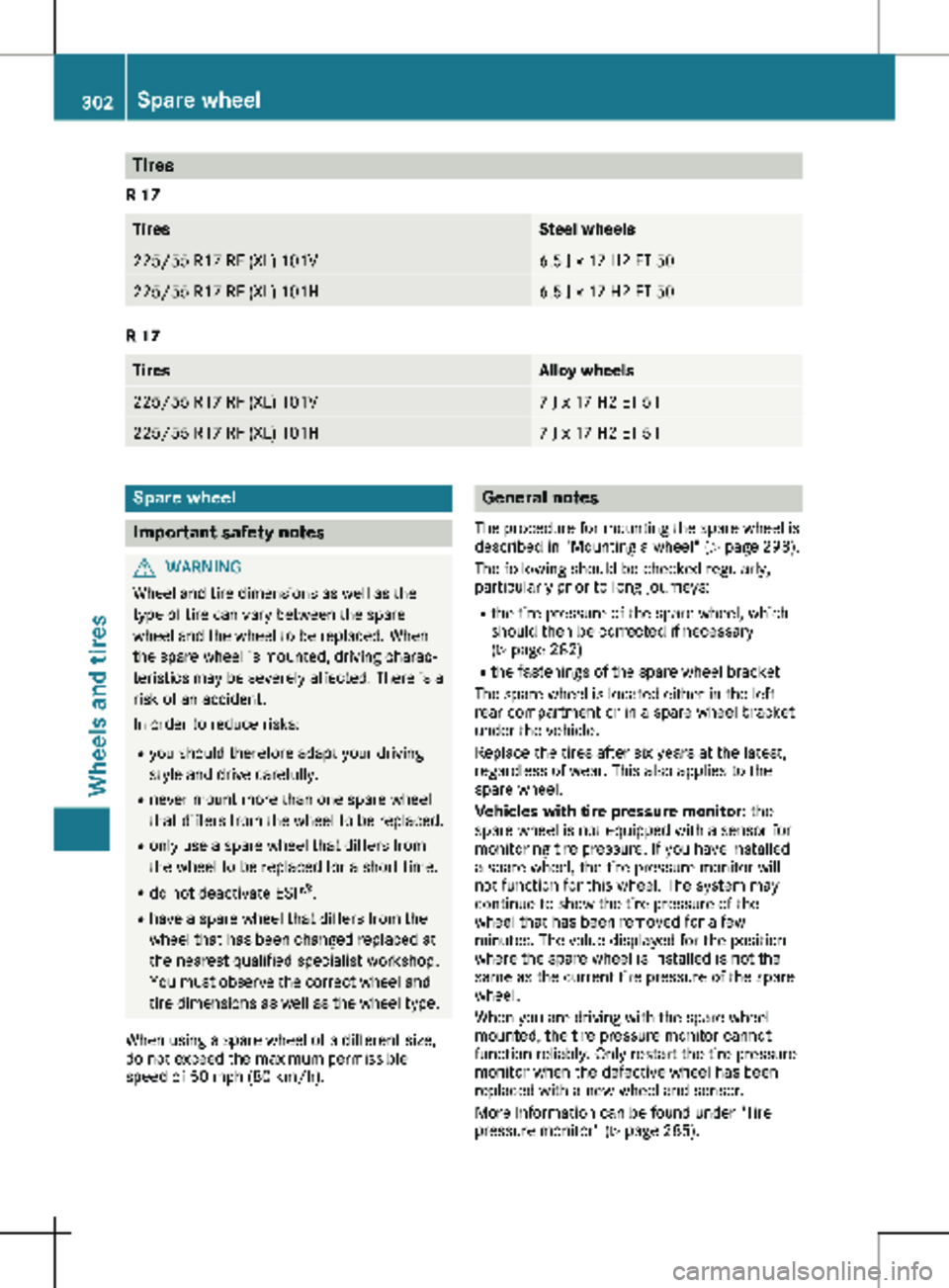
Tires
R 17 Tires Steel wheels
225/55 R17 RF (XL) 101V 6.5 J x 17 H2 ET 50
225/55 R17 RF (XL) 101H 6.5 J x 17 H2 ET 50
R 17
Tires Alloy wheels
225/55 R17 RF (XL) 101V 7 J x 17 H2 ET 51
225/55 R17 RF (XL) 101H 7 J x 17 H2 ET 51
Spare wheel
Important safety notes
G
WARNING
Wheel and tire dimensions as well as the
type of tire can vary between the spare
wheel and the wheel to be replaced. When
the spare wheel is mounted, driving charac-
teristics may be severely affected. There is a
risk of an accident.
In order to reduce risks:
R you should therefore adapt your driving
style and drive carefully.
R never mount more than one spare wheel
that differs from the wheel to be replaced.
R only use a spare wheel that differs from
the wheel to be replaced for a short time.
R do not deactivate ESP ®
.
R have a spare wheel that differs from the
wheel that has been changed replaced at
the nearest qualified specialist workshop.
You must observe the correct wheel and
tire dimensions as well as the wheel type.
When using a spare wheel of a different size,
do not exceed the maximum permissible
speed of
50 mph (80 km/h). General notes
The procedure for mounting the spare wheel is
described in "Mounting a wheel"
(Y page 298).
The following should be checked regularly,
particularly prior to long journeys:
R the tire pressure of the spare wheel, which
should then be corrected if necessary
(Y page 282)
R the fastenings of the spare wheel bracket
The spare wheel is located either in the left
rear compartment or in a spare wheel bracket
under the vehicle.
Replace the tires after six years at the latest,
regardless of wear. This also applies to the
spare wheel.
Vehicles with tire pressure monitor: the
spare wheel is not equipped with a sensor for
monitoring tire pressure. If you have installed
a spare wheel, the tire pressure monitor will
not function for this wheel. The system may
continue to show the tire pressure of the
wheel that has been removed for a few
minutes. The value displayed for the position
where the spare wheel is installed is not the
same as the current tire pressure of the spare
wheel.
When you are driving with the spare wheel
mounted, the tire pressure monitor cannot
function reliably. Only restart the tire pressure
monitor when the defective wheel has been
replaced with a new wheel and sensor.
More Information can be found under "Tire
pressure monitor" (Y page 285). 302
Spare wheel
Wheels and tires
Page 305 of 320
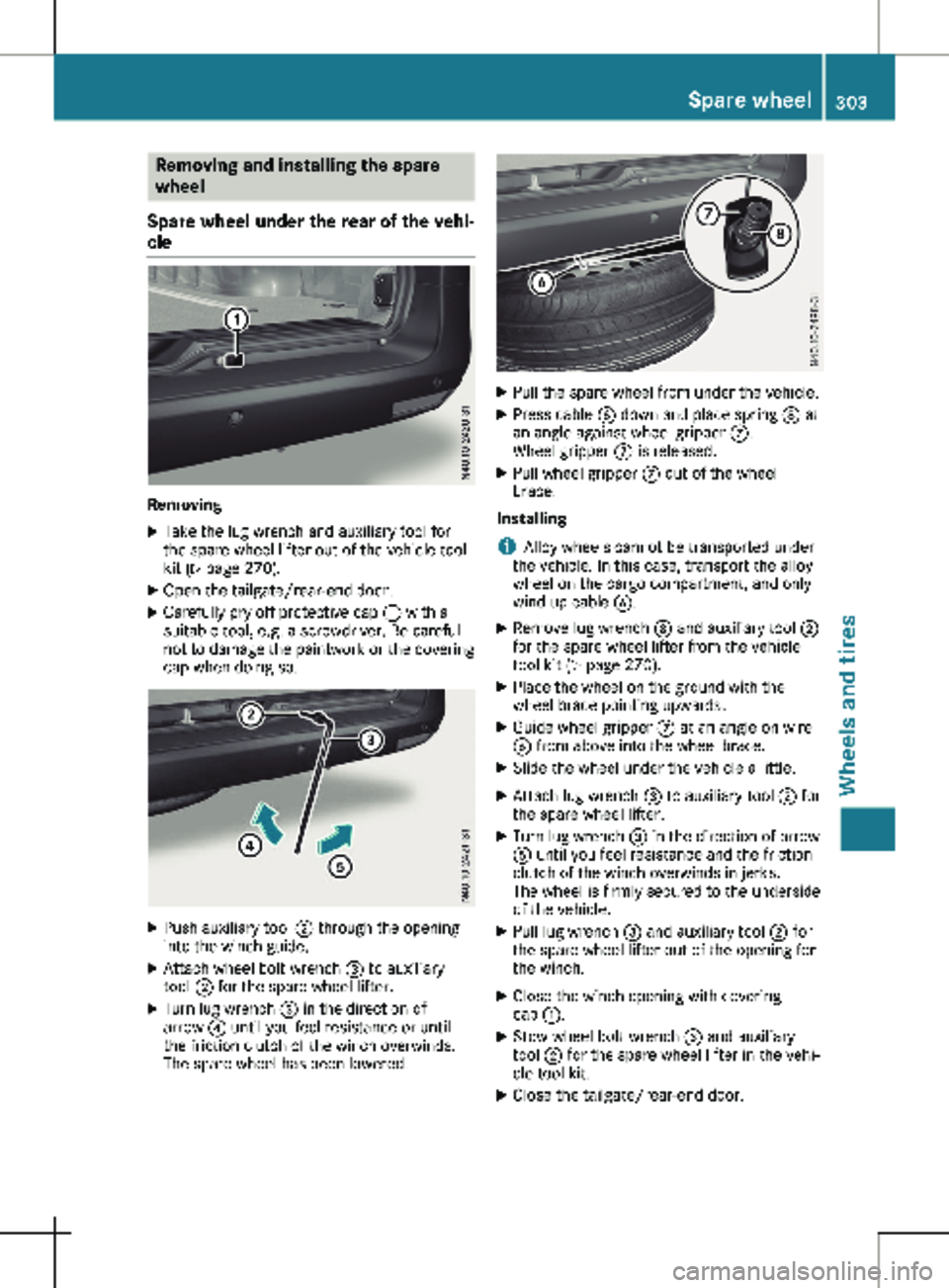
Removing and installing the spare
wheel
Spare wheel under the rear of the vehi-
cle Removing
X Take the lug wrench and auxiliary tool for
the spare wheel lifter out of the vehicle tool
kit
(Y page 270).
X Open the tailgate/rear-end door.
X Carefully pry off protective cap : with a
suitable tool, e.g. a screwdriver. Be careful
not to damage the paintwork or the covering
cap when doing so. X
Push auxiliary tool ; through the opening
into the winch guide.
X Attach wheel bolt wrench = to auxiliary
tool ; for the spare wheel lifter.
X Turn lug wrench = in the direction of
arrow ? until you feel resistance or until
the friction clutch of the winch overwinds.
The spare wheel has been lowered. X
Pull the spare wheel from under the vehicle.
X Press cable B down and place spring D at
an angle against wheel gripper C.
Wheel gripper C is released.
X Pull wheel gripper C out of the wheel
brace.
Installing
i Alloy wheels cannot be transported under
the vehicle. In this case, transport the alloy
wheel on the cargo compartment, and only
wind up cable B.
X Remove lug wrench = and auxiliary tool ;
for the spare wheel lifter from the vehicle
tool kit
(Y page 270).
X Place the wheel on the ground with the
wheel brace pointing upwards.
X Guide wheel gripper C at an angle on wire
B from above into the wheel brace.
X Slide the wheel under the vehicle a little.
X Attach lug wrench = to auxiliary tool ; for
the spare wheel lifter.
X Turn lug wrench = in the direction of arrow
A until you feel resistance and the friction
clutch of the winch overwinds in jerks.
The wheel is firmly secured to the underside
of the vehicle.
X Pull lug wrench = and auxiliary tool ; for
the spare wheel lifter out of the opening for
the winch.
X Close the winch opening with covering
cap :.
X Stow wheel bolt wrench = and auxiliary
tool ; for the spare wheel lifter in the vehi-
cle tool kit.
X Close the tailgate/rear-end door. Spare wheel
303
Wheels and tires Z
Page 306 of 320
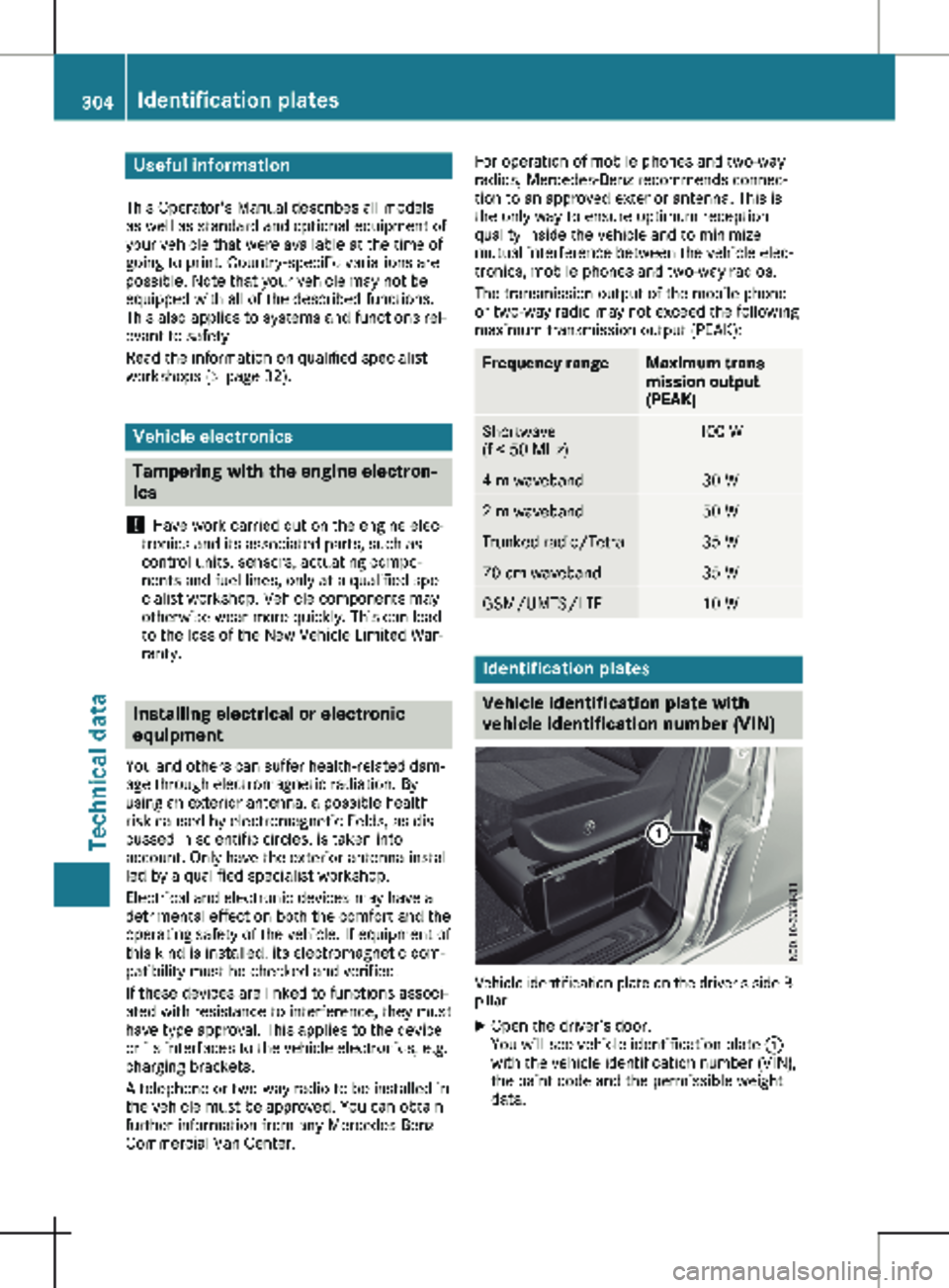
Useful information
This Operator's Manual describes all models
as well as standard and optional equipment of
your vehicle that were available at the time of
going to print. Country-specific variations are
possible. Note that your vehicle may not be
equipped with all of the described functions.
This also applies to systems and functions rel-
evant to safety.
Read the information on qualified specialist
workshops (Y page
32).Vehicle electronics
Tampering with the engine electron-
ics
! Have work carried out on the engine elec-
tronics and its associated parts, such as
control units, sensors, actuating compo-
nents and fuel lines, only at a qualified spe-
cialist workshop. Vehicle components may
otherwise wear more quickly. This can lead
to the loss of the New Vehicle Limited War-
ranty. Installing electrical or electronic
equipment
You and others can suffer health-related dam-
age through electromagnetic radiation. By
using an exterior antenna, a possible health
risk caused by electromagnetic fields, as dis-
cussed in scientific circles, is taken into
account. Only have the exterior antenna instal-
led by a qualified specialist workshop.
Electrical and electronic devices may have a
detrimental effect on both the comfort and the
operating safety of the vehicle. If equipment of
this kind is installed, its electromagnetic com-
patibility must be checked and verified.
If these devices are linked to functions associ-
ated with resistance to interference, they must
have type approval. This applies to the device
or its interfaces to the vehicle electronics, e.g.
charging brackets.
A telephone or two-way radio to be installed in
the vehicle must be approved. You can obtain
further information from any Mercedes-Benz
Commercial Van Center. For operation of mobile phones and two-way
radios, Mercedes-Benz recommends connec-
tion to an approved exterior antenna. This is
the only way to ensure optimum reception
quality inside the vehicle and to minimize
mutual interference between the vehicle elec-
tronics, mobile phones and two-way radios.
The transmission output of the mobile phone
or two-way radio may not exceed the following
maximum transmission output (PEAK): Frequency range Maximum trans-
mission output
(PEAK)
Shortwave
(f < 50 MHz
) 100 W
4 m waveband 30 W
2 m waveband 50 W
Trunked radio/Tetra 35 W
70 cm waveband 35 W
GSM/UMTS/LTE 10 W
Identification plates
Vehicle identification plate with
vehicle identification number (VIN)
Vehicle identification plate on the driver's side B-
pillar
X Open the driver’s door.
You will see vehicle identification plate :
with the vehicle identification number (VIN),
the paint code and the permissible weight
data. 304
Identification plates
Technical data
Page 307 of 320
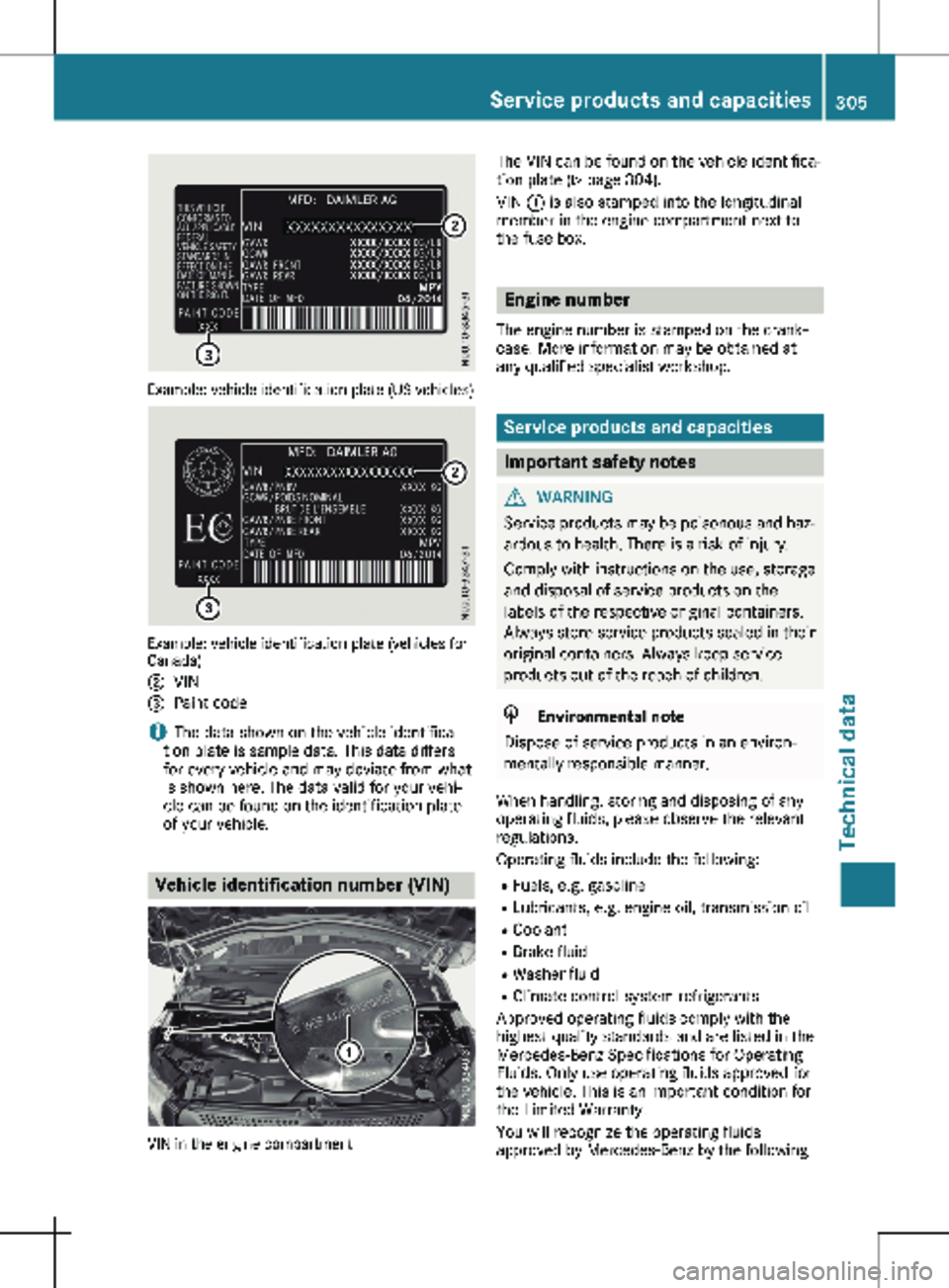
Example: vehicle identification plate (US vehicles)
Example: vehicle identification plate (vehicles for
Canada)
; VIN
= Paint code
i The data shown on the vehicle identifica-
tion plate is sample data. This data differs
for every vehicle and may deviate from what
is shown here. The data valid for your vehi-
cle can be found on the identification plate
of your vehicle. Vehicle identification number (VIN)
VIN in the engine compartment The VIN can be found on the vehicle identifica-
tion plate (Y page
304).
VIN : is also stamped into the longitudinal
member in the engine compartment next to
the fuse box. Engine number
The engine number is stamped on the crank-
case. More information may be obtained at
any qualified specialist workshop. Service products and capacities
Important safety notes
G
WARNING
Service products may be poisonous and haz-
ardous to health. There is a risk of injury.
Comply with instructions on the use, storage
and disposal of service products on the
labels of the respective original containers.
Always store service products sealed in their
original containers. Always keep service
products out of the reach of children. H
Environmental note
Dispose of service products in an environ-
mentally responsible manner.
When handling, storing and disposing of any
operating fluids, please observe the relevant
regulations.
Operating fluids include the following:
R Fuels, e.g. gasoline
R Lubricants, e.g. engine oil, transmission oil
R Coolant
R Brake fluid
R Washer fluid
R Climate control system refrigerants
Approved operating fluids comply with the
highest quality standards and are listed in the
Mercedes-Benz Specifications for Operating
Fluids. Only use operating fluids approved for
the vehicle. This is an important condition for
the Limited Warranty.
You will recognize the operating fluids
approved by Mercedes-Benz by the following Service products and capacities
305
Technical data Z
Page 308 of 320
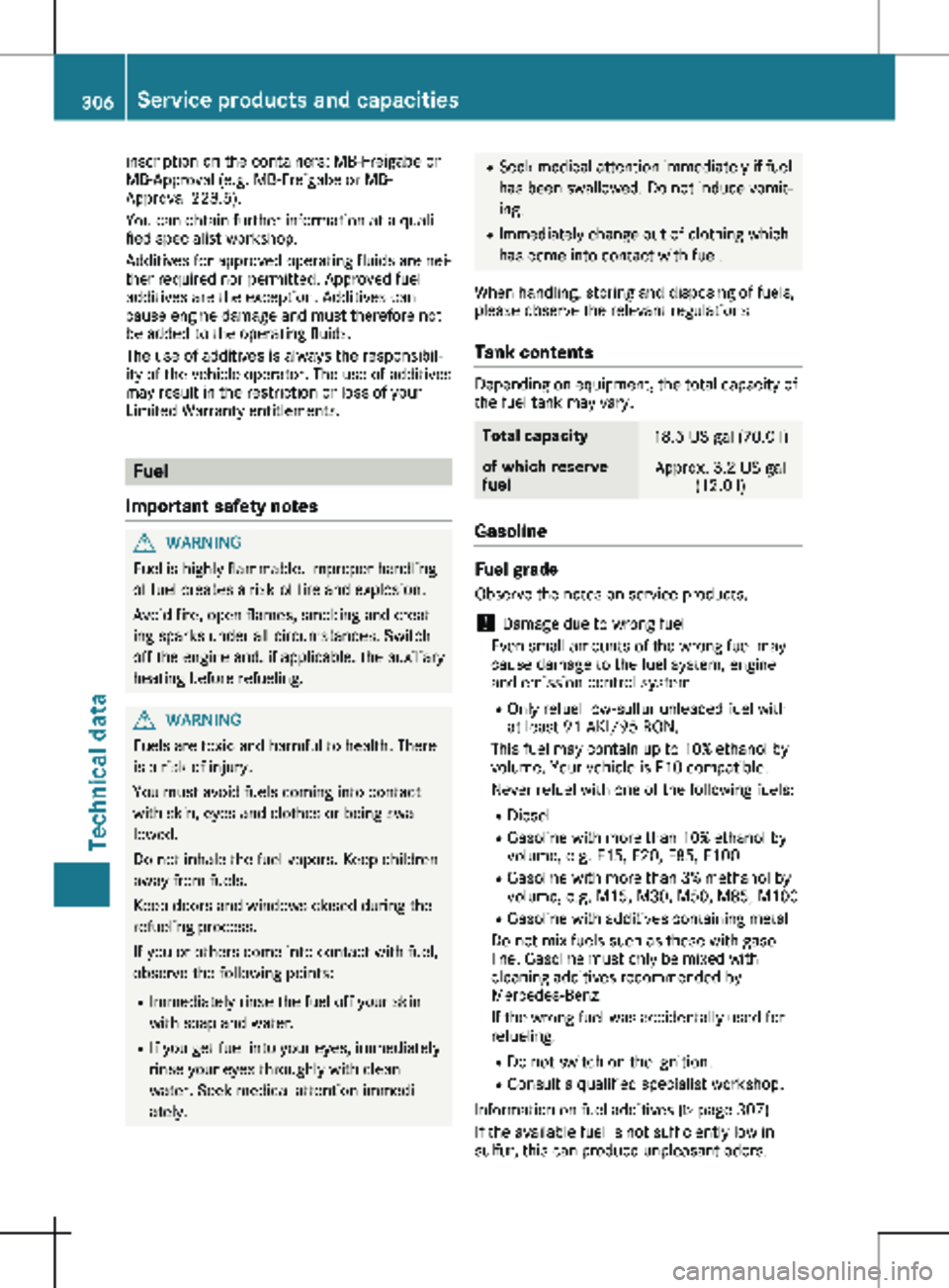
inscription on the containers: MB-Freigabe or
MB-Approval (e.g. MB-Freigabe or MB-
Approval 228.5).
You can obtain further information at a quali-
fied specialist workshop.
Additives for approved operating fluids are nei-
ther required nor permitted. Approved fuel
additives are the exception. Additives can
cause engine damage and must therefore not
be added to the operating fluids.
The use of additives is always the responsibil-
ity of the vehicle operator. The use of additives
may result in the restriction or loss of your
Limited Warranty entitlements. Fuel
Important safety notes G
WARNING
Fuel is highly flammable. Improper handling
of fuel creates a risk of fire and explosion.
Avoid fire, open flames, smoking and creat-
ing sparks under all circumstances. Switch
off the engine and, if applicable, the auxiliary
heating before refueling. G
WARNING
Fuels are toxic and harmful to health. There
is a risk of injury.
You must avoid fuels coming into contact
with skin, eyes and clothes or being swal-
lowed.
Do not inhale the fuel vapors. Keep children
away from fuels.
Keep doors and windows closed during the
refueling process.
If you or others come into contact with fuel,
observe the following points:
R Immediately rinse the fuel off your skin
with soap and water.
R If you get fuel into your eyes, immediately
rinse your eyes throughly with clean
water. Seek medical attention immedi-
ately. R
Seek medical attention immediately if fuel
has been swallowed. Do not induce vomit-
ing.
R Immediately change out of clothing which
has come into contact with fuel.
When handling, storing and disposing of fuels,
please observe the relevant regulations.
Tank contents Depending on equipment, the total capacity of
the fuel tank may vary.
Total capacity
18.5 US gal (70.0 l)
of which reserve
fuel
Approx. 3.2 US gal
(12.0 l ) Gasoline
Fuel grade
Observe the notes on service products.
! Damage due to wrong fuel
Even small amounts of the wrong fuel may
cause damage to the fuel system, engine
and emission control system.
R Only refuel low-sulfur unleaded fuel with
at least
91 AKI/95 RON.
This fuel may contain up to 10% ethanol by
volume. Your vehicle is E10 compatible.
Never refuel with one of the following fuels:
R Diesel
R Gasoline with more than 10% ethanol by
volume, e.g. E15, E20, E85, E100
R Gasoline with more than 3% methanol by
volume, e.g. M15, M30, M50, M85, M100
R Gasoline with additives containing metal
Do not mix fuels such as these with gaso-
line. Gasoline must only be mixed with
cleaning additives recommended by
Mercedes-Benz.
If the wrong fuel was accidentally used for
refueling:
R Do not switch on the ignition.
R Consult a qualified specialist workshop.
Information on fuel additives (Y page 307). If the available fuel is not sufficiently low in
sulfur, this can produce unpleasant odors. 306
Service products and capacities
Technical data
Page 309 of 320
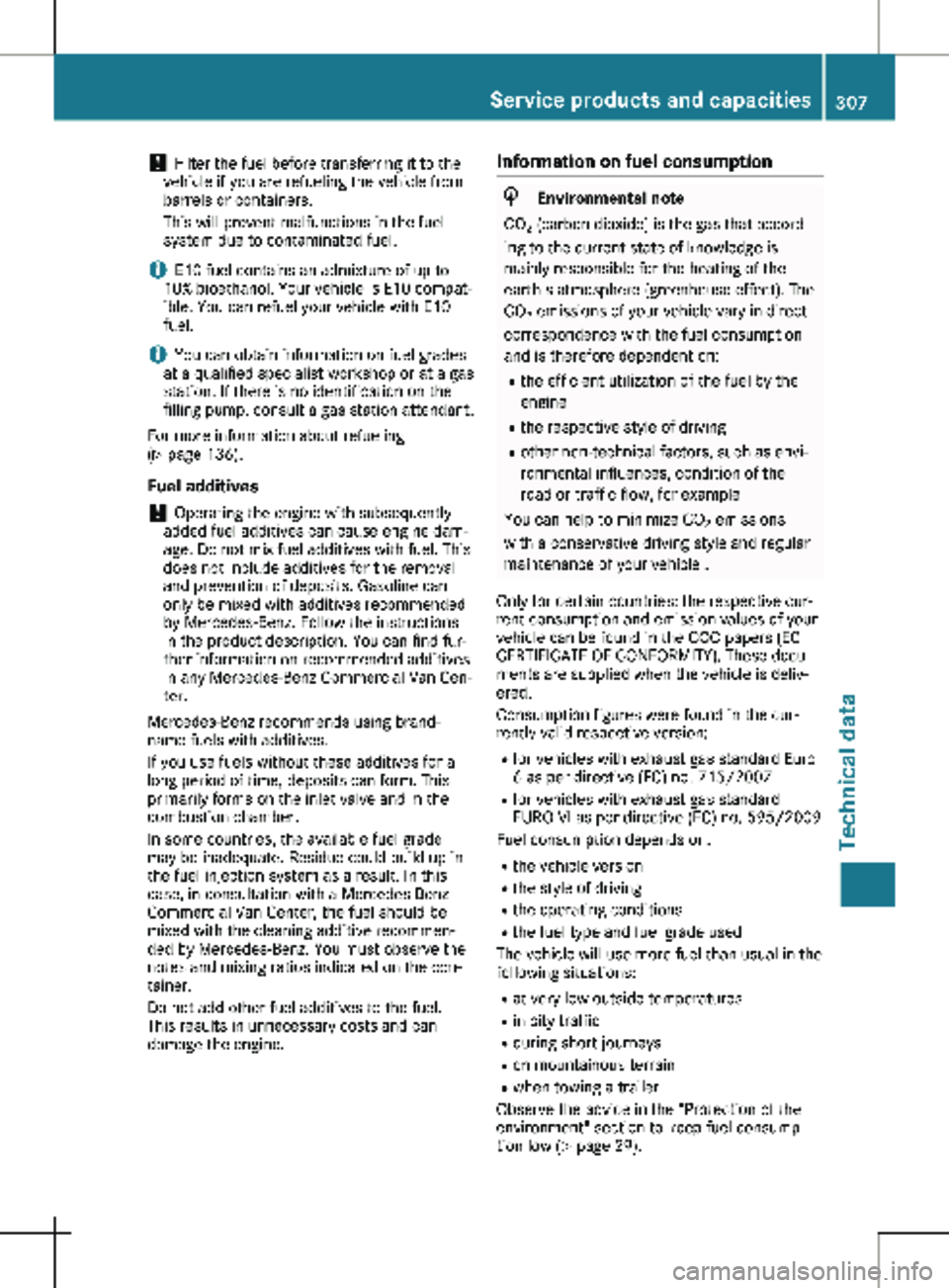
!
Filter the fuel before transferring it to the
vehicle if you are refueling the vehicle from
barrels or containers.
This will prevent malfunctions in the fuel
system due to contaminated fuel.
i E10 fuel contains an admixture of up to
10% bioethanol. Your vehicle is E10 compat-
ible. You can refuel your vehicle with E10
fuel.
i You can obtain information on fuel grades
at a qualified specialist workshop or at a gas
station. If there is no identification on the
filling pump, consult a gas station attendant.
For more information about refueling
(Y page
136).
Fuel additives
! Operating the engine with subsequently
added fuel additives can cause engine dam-
age. Do not mix fuel additives with fuel. This
does not include additives for the removal
and prevention of deposits. Gasoline can
only be mixed with additives recommended
by Mercedes-Benz. Follow the instructions
in the product description. You can find fur-
ther information on recommended additives
in any Mercedes-Benz Commercial Van Cen-
ter.
Mercedes-Benz recommends using brand-
name fuels with additives.
If you use fuels without these additives for a
long period of time, deposits can form. This
primarily forms on the inlet valve and in the
combustion chamber.
In some countries, the available fuel grade
may be inadequate. Residue could build up in
the fuel injection system as a result. In this
case, in consultation with a Mercedes-Benz
Commercial Van Center, the fuel should be
mixed with the cleaning additive recommen-
ded by Mercedes-Benz. You must observe the
notes and mixing ratios indicated on the con-
tainer.
Do not add other fuel additives to the fuel.
This results in unnecessary costs and can
damage the engine. Information on fuel consumption H
Environmental note
CO 2 (carbon dioxide) is the gas that accord-
ing to the current state of knowledge is
mainly responsible for the heating of the
earth's atmosphere (greenhouse effect). The
CO 2 emissions of your vehicle vary in direct
correspondence with the fuel consumption
and is therefore dependent on:
R the efficient utilization of the fuel by the
engine
R the respective style of driving
R other non-technical factors, such as envi-
ronmental influences, condition of the
road or traffic flow, for example
You can help to minimize CO 2 emissions
with a conservative driving style and regular
maintenance of your vehicle .
Only for certain countries: the respective cur-
rent consumption and emission values of your
vehicle can be found in the COC papers (EC
CERTIFICATE OF CONFORMITY). These docu-
ments are supplied when the vehicle is deliv-
ered.
Consumption figures were found in the cur-
rently valid respective version: R for vehicles with exhaust gas standard Euro
6 as per directive (EC) no. 715/2007
R for vehicles with exhaust gas standard
EURO VI as per directive (EC) no. 595/2009
Fuel consumption depends on:
R the vehicle version
R the style of driving
R the operating conditions
R the fuel type and fuel grade used
The vehicle will use more fuel than usual in the
following situations:
R at very low outside temperatures
R in city traffic
R during short journeys
R on mountainous terrain
R when towing a trailer
Observe the advice in the "Protection of the
environment" section to keep fuel consump-
tion low
(Y page 29). Service products and capacities
307
Technical data Z
Page 310 of 320
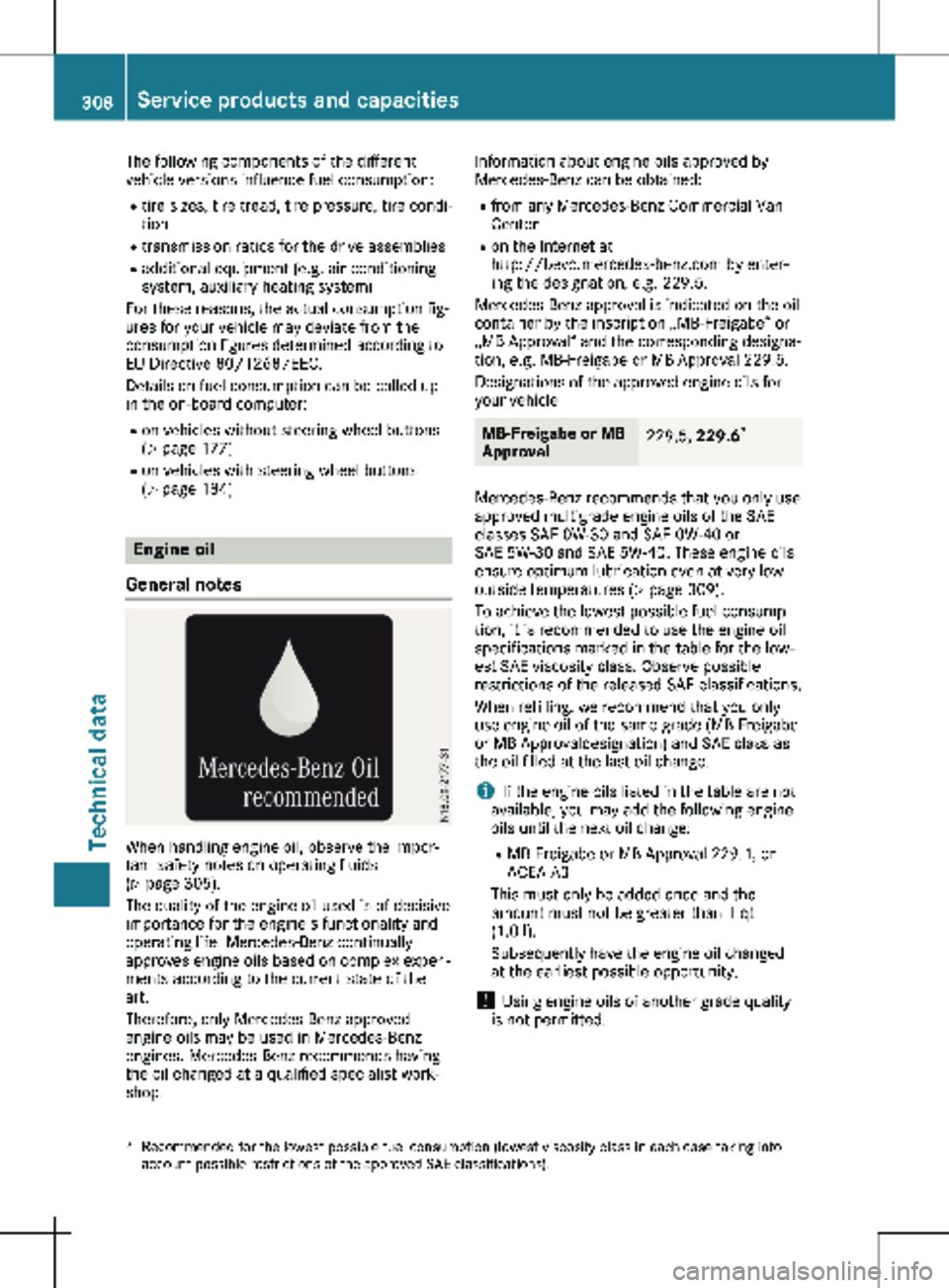
The following components of the different
vehicle versions influence fuel consumption:
R tire sizes, tire tread, tire pressure, tire condi-
tion
R transmission ratios for the drive assemblies
R additional equipment (e.g. air-conditioning
system, auxiliary heating system)
For these reasons, the actual consumption fig-
ures for your vehicle may deviate from the
consumption figures determined according to
EU Directive
80/1268/EEC.
Details on fuel consumption can be called up
in the on-board computer:
R on vehicles without steering wheel buttons
(Y page 177)
R on vehicles with steering wheel buttons
(Y page 184) Engine oil
General notes When handling engine oil, observe the impor-
tant safety notes on operating fluids
(Y page
305).
The quality of the engine oil used is of decisive
importance for the engine's functionality and
operating life. Mercedes-Benz continually
approves engine oils based on complex experi-
ments according to the current state of the
art.
Therefore, only Mercedes-Benz approved
engine oils may be used in Mercedes-Benz
engines. Mercedes-Benz recommends having
the oil changed at a qualified specialist work-
shop. Information about engine oils approved by
Mercedes-Benz can be obtained:
R from any Mercedes-Benz Commercial Van
Center
R on the Internet at
http://bevo.mercedes-benz.com
by enter-
ing the designation, e.g. 229.5.
Mercedes-Benz approval is indicated on the oil
container by the inscription „MB-Freigabe“ or
„MB Approval“ and the corresponding designa-
tion, e.g. MB-Freigabe or MB Approval 229.5.
Designations of the approved engine oils for
your vehicle MB-Freigabe or MB
Approval
229.5,
229.62 Mercedes-Benz recommends that you only use
approved multigrade engine oils of the SAE
classes
SAE 0W-30 and SAE 0W-40 or
SAE 5W-30 and SAE 5W-40. These engine oils
ensure optimum lubrication even at very low
outside temperatures (Y page 309).
To achieve the lowest possible fuel consump-
tion, it is recommended to use the engine oil
specifications marked in the table for the low-
est SAE viscosity class. Observe possible
restrictions of the released SAE classifications.
When refilling, we recommend that you only
use engine oil of the same grade (MB-Freigabe
or MB Approvaldesignation) and SAE class as
the oil filled at the last oil change.
i If the engine oils listed in the table are not
available, you may add the following engine
oils until the next oil change:
R MB-Freigabe or MB Approval 229.1, or
ACEA A3
This must only be added once and the
amount must not be greater than 1 qt
(1.0 l).
Subsequently have the engine oil changed
at the earliest possible opportunity.
! Using engine oils of another grade quality
is not permitted.
2 Recommended for the lowest possible fuel consumption (lowest viscosity class in each case taking into
account possible restrictions of the approved SAE classifications). 308
Service products and capacities
Technical data